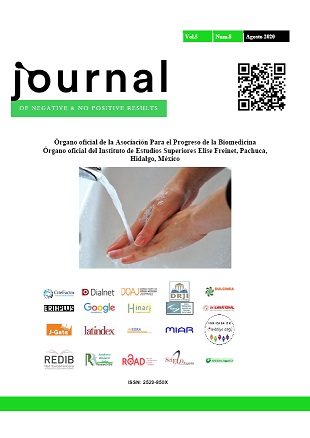Impact of COVID-19 on women's emotions: pregnant women with gestational diabetes
DOI:
https://doi.org/10.19230/jonnpr.3765Keywords:
gestational diabetes, COVID-19, pregnant women, emotionsAbstract
Aim. To determine the impact of COVID-19 on the emotions of pregnant women with gestational diabetes.
Material and Methods. Cross-sectional, observational study in 85 pregnant women with gestational diabetes who attends the IMSS Regional General Hospital 200, uses the instrument The Mood Assessment Scale (EVEA) was created by Sanz in 2001 with a validity and reliability of 0.86 and 0.92.
Expected results. Pregnant women with gestational diabetes had an emotional impact due to the COVID-19 pandemic and not only because of the fear of catching the fear of having to go to the hospital at these times of crisis to labor and that This is complicated by both situations.
Conclusion. Fear is one of the most shocking emotions in pregnant women in terms of reaching these days to be impacted by COVID-19, to manifest complications in them or in their baby, in the face of this crisis by COVID-19 they anticipate results negatives.
Downloads
References
Medina-Pérez EA, Sánchez-Reyes A, Hernández-Peredo AR, Martínez-López MA, Jiménez-Flores CN, Serrano- Ortiz I et al . Diabetes gestacional. Diagnóstico y tratamiento en el primer nivel de atención. Med. Interna Méx. 2017 ; 33(1): 91-98. Disponible en: http://www.scielo.org.mx/scielo.php?script=sci_arttext&pid=S0186-48662017000100091&lng=es.
Pulido S. La OMS declara la Emergencia de Salud Pública Internacional. Gaceta medica 2020. Disponible en https://gacetamedica.com/
Hernández Yero A, Por qué los diabéticos son grupo de riesgo frente a la infección COVID-19. Rev. Venez. Endocrinol. Metab 2020; 10( 1 ): 7-12. Disponible en: http://articulos.sld.cu/diabetes/2020/04/30/por-que-los- diabeticos-son-grupo-de-riesgofrente-a-la-infeccion-covid-19/
García-García E, De la Llata-Romero M, Kaufer-Horwitz M, Tusié-Luna MT, Calzada-León R, Vázquez-Velázquez V. La obesidad y el síndrome metabólico como problema de salud pública: una reflexión. Salud pública Méx. 2008; 50(6): 530-547. Disponible en: http://www.scielo.org.mx/scielo.php?script=sci_arttext&pid=S0036-36342008000600015&lng=es.
Ramos, C. COVID-19: la nueva enfermedad causada por un coronavirus. Salud Pública de México, 62(2, Mar- Abr), 225-227. Disponible en: http://dx.doi.org/10.21149/11276
Valero N, Larreal Y, Mosquera M, Rincón E. Síndrome Respiratorio Agudo Severo (SRAS): Lecciones y Retos. Invest. Clín. 2005; 46( 1 ): 75-95. Disponible en: http://ve.scielo.org/scielo.php?script=sci_arttext&pid=S0535-51332005000100009&lng=es.
Alpuche Aranda, C. (2020). Infecciones emergentes, el gran reto de la salud global: COVID-19. Salud Pública de México, 62 (2, Mar-Abr), 123-124. Disponible en: http://dx.doi.org/10.21149/11284
Zhang J, Wang Y, Chen L, et al. Análisis clínico de embarazo en segundo y tercer trimestre complicado síndrome respiratorio agudo severo. Zhonghua Fu Chan Ke Za Zhi 2003; 38: 516-20. Disponible en: http://www.fasgo.org.ar/images/2020-03-21-covid19-pregnancy-guidance-2118.en.esespanol.pdf
Esparza Romero J. Diabetes y COVID-19: situación en México y recomendaciones para pacientes. Salud Pública de México, 62(2, Mar-Abr), 123-124.Disponible en: https://www.ciad.mx/notas/item/2328-diabetes-y-covid-19- situacion-en-mexico-yrecomendaciones-para-pacientes
COVID-19: orientación sobre el distanciamiento social y para las personas vulnerables 2020.Disponible en: https://www.gov. uk/gobierno /publicaciones / covid-19-guía-asocial-distanciamiento-and-para-vulnerables, personas Accessed March 17 para 2020
Mejias Quintero Mileidy Egleet, Huertas González José María, Salem Salem Haidar. Citomegalovirus y embarazo: reporte de dos casos clínicos. Rev. peru. ginecol. obstet. 2016 Ene; 62( 1 ): 77-83. Disponible en: http://www.scielo.org.pe/scielo.php?script=sci_arttext&pid=S2304-51322016000100008&lng=es.
Lugones Botell M, Ramírez Bermúdez M. Curioso origen y significado de la palabra embarazada. Rev Cubana Obstet Ginecol. 2015 ; 41(1): 90-98. Disponible en: http://scielo.sld.cu/scielo.php?script=sci_arttext&pid=S0138-600X2015000100011&lng=es.
Figuero-Ruiz E., Prieto Prieto I., Bascones-Martínez A.. Cambios hormonales asociados al embarazo: Afectación gingivo-periodontal. Avances en Periodoncia. 2006; 18(2): 101-113. Disponible en: http://scielo.isciii.es/scielo.php?script=sci_arttext&pid=S1699-65852006000200005&lng=es.
Ojeda González José, Rodríguez Älvarez Maritza, Estepa Pérez Jorge, Piña Loyola Carmen, Cabeza Poblet Bárbara. Cambios fisiológicos durante el embarazo. Su importancia para el anestesiólogo. Medisur. 2011; 9( 5 ): 484-491. Disponible en: http://scielo.sld.cu/scielo.php?script=sci_arttext&pid=S1727-897X2011000500011&lng=es.
Ríos-Martínez W, García-Salazar Anette M, Ruano-Herrera L, Espinosa-Velasco MJ, Zárate A, Hernández- Valencia M. Complicaciones obstétricas de la diabetes gestacional: criterios de la IADPSG y HAPO. Perinatol. Reprod. Hum. 2014; 28(1): 27-32. Disponible en: http://www.scielo.org.mx/scielo.php?script=sci_arttext&pid=S0187-53372014000100005&lng=es.
Rimbao Torres G, Cruz Hernández S,Enríquez O, Rodríguez Izquierdo A, Morales Chamizo M, Velasco Boza A. Comportamiento de la diabetes gestacional en el embarazo en la adolescencia. Rev Cubana Med Gen Integr 2007; 23( 3). Disponible en: http://scielo.sld.cu/scielo.php?script=sci_arttext&pid=S0864-21252007000300008&lng=es.
Chen H, Guo J, Wang C, et al. Las características clínicas y el potencial de transmisión vertical intrauterina de la infección CUBRE ID-19 de cada nueve mujeres embarazadas: una revisión retrospectiva de las historias clínicas. The Lancet 2020 Disponible en: https: // doi.org/10.1016/S0140-6736(20)30360-3
Tasmania del Pino S, Peñate Castro W, Bethencourt Pérez , JM. La escala de valoración del estado de ánimo (EVEA). Análisis y Modificación de Conducta 2010, 36(153), 19-32. Disponible en: http://rabida.uhu.es/dspace/bitstream/handle/10272/6066/La_escala_de_valoracion_del_estado_de_animo.pdf? sequence=2
Published
Issue
Section
License
All accepted originals remain the property of JONNPR. In the event of publication, the authors exclusively transfer their rights of reproduction, distribution, translation and public communication (by any sound, audiovisual or electronic medium or format) of their work. To do so, the authors shall sign a letter transferring these rights when sending the paper via the online manuscript management system.
The articles published in the journal are freely used under the terms of the Creative Commons BY NC SA license, therefore.
You are free to:
Share — copy and redistribute the material in any medium or format
Adapt — remix, transform, and build upon the material
The licensor cannot revoke these freedoms as long as you follow the license terms.
Under the following terms:
Attribution — You must give appropriate credit, provide a link to the license, and indicate if changes were made. You may do so in any reasonable manner, but not in any way that suggests the licensor endorses you or your use.
NonCommercial — You may not use the material for commercial purposes.
ShareAlike — If you remix, transform, or build upon the material, you must distribute your contributions under the same license as the original.
No additional restrictions — You may not apply legal terms or technological measures that legally restrict others from doing anything the license permits.

This work is licensed under a Creative Commons Attribution-NonCommercial-ShareAlike 4.0 International License

























